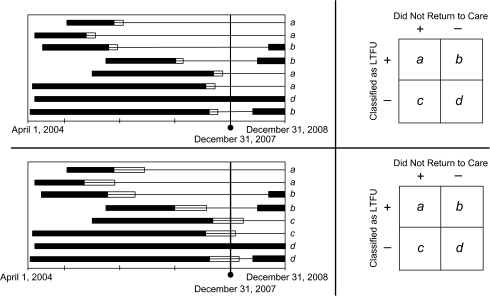Figure 1.
Method used to evaluate the performance of many different intervals for defining loss to follow-up (LTFU) in a multisite human immunodeficiency virus treatment cohort, Lusaka, Zambia, 2004–2007. Once a specific interval is selected, patients are classified as “active” or LTFU as of December 31, 2007. We then document whether they return to care during the 2008 calendar year. Each bar represents a patient who has started antiretroviral therapy. The black portion represents the period for which a patient is active in care and not late for an appointment. If a patient becomes late for an appointment during the course of his or her follow-up, this is depicted by a thin black line. The white portion of each bar represents the interval in which lateness for a scheduled visit is “allowable” and not considered LTFU. The length of this white bar represents the threshold definition that we are primarily examining in this analysis. In the 2 panels, we demonstrate how differences in the LTFU threshold can affect the classification of patients. Patients categorized as a are LTFU as of December 31, 2007, and do not return to care during the next year (true positives). Those categorized as b were originally classified as LTFU but return to care (false positives). Those in c are classified as active on December 31, 2007, but fail to return for subsequent appointments (false negatives). Group d comprises patients who are classified as active at the cutoff date and remain active during the coming year (true negatives). Using this 2 × 2 table, we are able to calculate sensitivity (a/a + c) and specificity (d/b + d) for each LTFU threshold.

